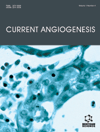- Home
- A-Z Publications
- Current Angiogenesis (Discontinued)
- Previous Issues
- Volume 3, Issue 3, 2014
Current Angiogenesis (Discontinued) - Volume 3, Issue 3, 2014
Volume 3, Issue 3, 2014
-
-
Potential Role of Calcium/Calmodulin-dependent Protein Kinase II to Angiogenesis Mediated Pathological Changes Seen in Osteoarthritis
More LessBy Sadaf AshrafOsteoarthritis (OA), one of the commonest joint diseases of unknown aetiology is a major source of pain and disability in the ageing population. OA is associated with chondropathy, synovitis, subchondral bone remodelling and osteophyte formation. Angiogenesis, the growth of new blood vessels from preexisting ones may contribute to each of these features. Synovitis is increasingly recognised as an important feature of OA and Read More
-
-
-
Novel Function of Beta 2 Glycoprotein I in Angiogenesis
More LessAuthors: Hisako Nakagawa, Shinsuke Yasuda and Tadaaki Miyazakiβ2-glycoprotein I (β2GPI) is an important autoantigen in patients with antiphospholipid syndrome (APS), an autoimmune disorder characterized by thrombosis and pregnancy morbidity. β2GPI is able to bind to anionic phospholipid via the lysine cluster and hydrophobic loop in the domain V Cys281-Cys288 region. It also binds annexin II, oxLDL, and apoptotic cells. As a result β 2GPI plays a role in a broad range of pleiotropic f Read More
-
-
-
Sequential Gene Expression Analysis of Coagulation Factors and Proteaseactivated Receptors in Hematopoietic Lineage Development
More LessAuthors: Shogo Kasuda, Yoshihiko Sakurai, Kohei Tatsumi, Junko Kato, Tomohiro Takeda, Midori Shima and Katsuhiko HatakeThe hematopoietic lineage is derived from pre-mesodermal cells and differentiates into hematopoietic and endothelial cells. The hematopoietic lineage cells play a key role in vasculogenesis during fetal development. Coagulation factors are essential for embryonic development and may also contribute to hematopoietic differentiation. The role of these factors and their corresponding protease-activated receptors (PARs) in the Read More
-
-
-
Angiogenic Properties of Primary Cells Intended at Bone Regeneration: A Comparison to Differentiated Cells Using the CAM Assay
More LessAuthors: Johanna Buschmann, Tatjana Siebert, Manfred Welti and Pietro GiovanoliStem cells and their differentiated off-springs are often used in the field of regenerative medicine and bone tissue engineering. As sufficient vascularization of bone grafts remains a main bottleneck, knowledge about angiogenic properties of these cell types is a prerequisite for choosing the best approach. The chorioallantoic membrane (CAM) assay was used to study the impact of three primary human cell types (adipos Read More
-
-
-
Modulation of Angiogenesis by Inflammatory Markers and the Role of Matrix Metalloproteinases in an Endothelial Cell/Fibroblast Co-culture System
More LessAuthors: Gemma A. Barron, Elise Bordet, Marie Goua and Giovanna BermanoIncreased levels of inflammatory markers such as tumour necrosis factor-α (TNFα) and interleukin- 6 (IL-6) have been associated with formation of new blood vessels, or angiogenesis, and linked to chronic inflammation in obesity. This study aimed to establish and use a versatile co-culture cell system to further investigate the role of TNFα and IL-6 in modulating (i) tubule formation and (ii) cell-cell interactions via matrix metallo Read More
-
-
-
VEGFA and PlGF Protein Signature of Primary Stage IV Rectal Cancer Pre and Post Neoadjuvant Radiotherapy, Bevacizumab, and Chemotherapy
More LessVascular endothelial growth factor-A (VEGFA) and placental growth factor (PlGF) can mediate cancer progression and anticancer treatment failure. We therefore analyzed (sub)cellular patterns of VEGFA and PlGF expression, and mean vessel density (MVD) in primary rectal tumor samples of stage IV patients, who could benefit from improved therapies. VEGFA, PlGF and MVD were measured immunohistochemically in paraffin- Read More
-
Volumes & issues
Most Read This Month
Article
content/journals/cag
Journal
10
5
false
en


